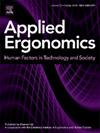User comfort and naturalness of automated driving: The effect of vehicle kinematic and proxemic factors on subjective response
IF 3.1
2区 工程技术
Q2 ENGINEERING, INDUSTRIAL
引用次数: 0
Abstract
User comfort in higher-level Automated Vehicles (AVs, SAE Level 4+) is crucial for public acceptance. AV driving styles, characterised by vehicle kinematic and proxemic factors, affect user comfort, with “human-like” driving styles expected to provide natural feelings. We investigated a) how the kinematic and proxemic factors of an AV's driving style affect users' evaluation of comfort and naturalness, and b) how the similarities between automated and users' manual driving styles affect user evaluation.
Using a motion-based driving simulator, participants experienced three Level 4 automated driving styles: two human-like (defensive, aggressive) and one machine-like. They also manually drove the same route. Participants rated their comfort and naturalness of each automated controller, across twenty-four varied UK road sections. We calculated maximum absolute values of the kinematic and proxemic factors affecting the AV's driving styles in longitudinal, lateral, and vertical directions, for each road section, to characterise the automated driving styles. The Euclidean distance between AV and manual driving styles, in terms of kinematic and proxemic factors, was calculated to characterise the human-like driving style of the AV.
We used mixed-effects models to examine a) the effect of AV's kinematic and proxemic factors on the evaluation of comfort and naturalness, and b) how similarities between manual and automated driving styles affected the evaluation. Results showed significant effects of lateral and rotational kinematic factors on comfort and naturalness, with longitudinal kinematic factors having a less prominent effect. Similarities in vehicle metrics, such as speed, longitudinal jerk, lateral offset, and yaw, between manual and automated driving styles, enhanced user comfort and naturalness.
This research facilitates an understanding of how control features of AVs affect user experience, contributing to the design of user-centred controllers and better acceptance of higher-level AVs.
自动驾驶的用户舒适度和自然度:车辆运动学和近似因素对主观反应的影响
高级自动驾驶汽车(AV,SAE 4+级)的用户舒适度对公众接受度至关重要。以车辆运动学和近似因素为特征的自动驾驶汽车驾驶风格会影响用户舒适度,而 "类人 "驾驶风格有望提供自然感受。我们研究了 a) 自动驾驶汽车驾驶风格的运动学和近似因素如何影响用户对舒适度和自然度的评价,以及 b) 自动驾驶风格和用户手动驾驶风格之间的相似性如何影响用户评价。他们还手动驾驶了相同的路线。在英国的 24 个不同路段,参与者对每个自动控制器的舒适度和自然度进行了评分。我们计算了每个路段中影响自动驾驶汽车驾驶风格的纵向、横向和垂直方向的运动学和近程因素的最大绝对值,以描述自动驾驶汽车的驾驶风格。我们使用混合效应模型研究了 a) AV 的运动学和近似因素对舒适性和自然性评价的影响,以及 b) 手动和自动驾驶风格之间的相似性如何影响评价。结果表明,横向和旋转运动学因素对舒适性和自然度有明显影响,纵向运动学因素的影响则不太明显。手动和自动驾驶方式在速度、纵向颠簸、横向偏移和偏航等车辆指标上的相似性提高了用户的舒适度和自然度。这项研究有助于了解自动驾驶汽车的控制功能如何影响用户体验,从而有助于设计以用户为中心的控制器,并提高人们对更高级自动驾驶汽车的接受程度。
本文章由计算机程序翻译,如有差异,请以英文原文为准。
求助全文
约1分钟内获得全文
求助全文
来源期刊

Applied Ergonomics
工程技术-工程:工业
CiteScore
7.50
自引率
9.40%
发文量
248
审稿时长
53 days
期刊介绍:
Applied Ergonomics is aimed at ergonomists and all those interested in applying ergonomics/human factors in the design, planning and management of technical and social systems at work or leisure. Readership is truly international with subscribers in over 50 countries. Professionals for whom Applied Ergonomics is of interest include: ergonomists, designers, industrial engineers, health and safety specialists, systems engineers, design engineers, organizational psychologists, occupational health specialists and human-computer interaction specialists.
 求助内容:
求助内容: 应助结果提醒方式:
应助结果提醒方式:


